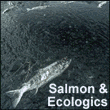forum
library
tutorial
contact

Can Scat, Diet, Breath
Give Clues to Orca Decline?
by Phuong Lee, Associated PressThe Seattle Times, December 20, 2008
|
the film forum library tutorial contact |

|
Can Scat, Diet, Breath
by Phuong Lee, Associated Press |
SEATTLE - When seven resident killer whales that frequent inland waters of Washington went missing this year, there was no shortage of suspects.
Are the orcas starving because of dwindling salmon runs? Is a toxic brew of oil, sewage and pollutants putting them at risk? Or is vessel noise disrupting their ability to find food?
"We're losing animals and we don't exactly understand why," said Brad Hanson, a wildlife biologist with the National Oceanic and Atmospheric Administration Fisheries Service.
Scientists are turning to new techniques to solve the question of the endangered species' decline, using satellite tracking and analyzing whale scat, breath samples and fish scales.
For the first time, the Center for Whale Research on San Juan Island will tag the southern resident population of killer whales to track their winter migration.
While the region's signature whales have been studied for more than three decades, it's a mystery where they go and what they eat when they leave the Puget Sound.
Starting next year, researchers will attach two-inch satellite tags on the dorsal fins of the orcas - two from each of the J, K and L pods, or families.
What risk factors do they face in the open ocean? What else is limiting their population? wonders Balcomb, the center's senior scientist.
For the past seven years, the K and L pods have been showing up in central California, an indication they may be foraging farther for salmon.
"We've got to think bigger about the whole food issue," said Joe Gaydos, a wildlife veterinarian and regional director of the SeaDoc Society.
What the whales eat when they leave Puget Sound has implications for salmon harvest in other areas like California and Alaska, he said.
University of Washington researchers analyzing whale scat have found signs that the mammals were "nutritionally stressed" this year.
Using a trained dog to sniff for poop and a 2-liter bottle on a telescoping pole, they've been collecting and analyzing stress hormones and toxins in the whales.
After three years of study, UW researchers have found a link between whale mortality and low levels of thyroid hormone, which partly controls metabolism. When whale deaths are up, thyroid levels are down, suggesting that the whales are starving.
The results are still preliminary and unpublished, but Sam Wasser, director of the UW Center for Conservation Biology, said they show a consistent nutritional problem.
When whales don't eat much, they draw down their fat reserves, where toxins are stored, said Katherine Ayres, a graduate student doing work under Wasser. When that happens, toxins enter the circulation system and could cause health problems, she said.
It's unclear whether the whales are strictly starving or whether they're becoming more susceptible to disease, but it all goes back to food, she said.
"The future for the fisheries is grim, and it's going to get worse," Balcomb said. "I expect that we'll have a worsening of the whale situation."
The resident Puget Sound orca population now stands at 83. Particularly troubling is the loss this year of two female whales of reproductive age among the seven presumed dead.
Studies show orcas prefer Chinook salmon, a species listed as threatened or endangered in several waterways in the northwest, including Puget Sound and the Columbia River.
Scientists are trying to better understand which salmon runs are important to the orcas.
"We're taking a long hard look at which runs correlate with births and deaths," Hanson said. "That has tremendous implication for our ability to improve conservation."
Once they've collected fish scales and other remains the orcas leave behind after feeding, Hanson and others run it through a genetic database that allows them to identify the species in a way they weren't able to a few years ago.
The lack of prey may not be the only barrier to orca feeding. Vessel noise may disrupt the mammal's ability to find food.
To date, four citations have been issued under a new state law designed to keep vessels farther away from whales. Among the offenders were two different Canada-based whale-watching operations ticketed for coming within 300 feet of the orcas, said Sgt. Russ Mullins with the state Department of Fish and Wildlife.
NOAA Fisheries is also writing new rules for vessels operating in federal waters.
Lack of food leads to other problems, including increased susceptibility to disease, said J.Pete Schroeder, a marine mammal veterinarian and director of research with Global Research and Rescue.
Schroeder and others have been capturing the breath droplets the whales emit from their blowholes.
They're studying potentially harmful organisms in the thin sea surface layer of the Puget Sound and in the breath samples of the orcas.
The researchers ride alongside the whales and swing petri dishes attached to long poles to capture air droplets from the blowhole.
Schroeder found that the orcas carry at least 13 antibiotic-resistant bacteria. Pathogens normally live in blowholes and upper respiratory tracts without causing disease, but whales with a suppressed immune system can become infected.
"There are diseases out there that can wipe out this population," Gaydos said.
All of this collective research will enable scientists to build a health assessment profile for the individual whales, Schroeder said.
Advocates argue that the orcas' problems should be seen as a call to action to clean up Puget Sound because the whales' decline means something far greater that losing the species itself.
"It means that the whole habitat is losing its ability to sustain life," said Howard Garrett, director of the Orca Network.
Related Sites:
Center for Whale Research
National Marine Fisheries Service
Global Research and Rescue
University of Washington Center for Conservation Biology
learn more on topics covered in the film
see the video
read the script
learn the songs
discussion forum
